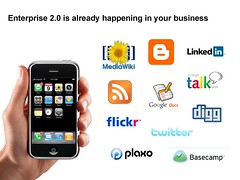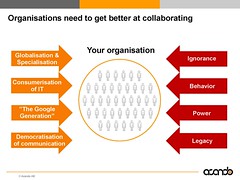


Enterprise Social Computing is the next generation of online collaborative technologies and practices that people use within the enterprise to share knowledge, expertise, experiences and insight with each other. (Definition: IT @ Intel)
Over the last few years, as open APIs, social networking platforms, cloud computing, open identity services, sensor-driven databases (such as with GPS and OpenStreetMap), or even people (example: Amazon’s Mechanical Turk) have created open ecosystems in which anyone can participate, including business, both to contribute and to consume, the Web has become the ultimate ‘people platform’ and one that is incredibly agile too, combined with economies of scale that are very hard to match. However it has thrown up its own challenges, unpredictabilities and risks which must be dealt with both routinely and successfully.
To perform well in this changing business environment organizations have adopted a more positive mindset towards Enterprise 2.0 technologies, since many enable the empowerment of the employees, making the organization nimbler and more innovative in a very challenging world. These also serve to protect the heart and soul of the enterprise- it’s knowledge.
Some of the reasons why Enterprise 2.0 is taking off are:
Protection of Intellectual Property
Employees in all enterprises are already using open ‘insecure’ social media tools. Knowledge workers use these tools for many reasons including how they fit their lifestyles, are universally accessible, easy to use and most of all are highly empowering. However for enterprises, these lead to increased concerns about ‘intellectual property’ and other information assets. This is because many of these sites have policies that effectively require users to give up their right to privacy. Also some of the sites can lay
Thus there is a need to define balanced security measures and controls, update use policies and ensure all employees know how to use these technologies appropriately. Additionally, if enterprises do not take up such initiatives e.g. Intel IT which provided its own social computing platform, the use of fragmented internal tools and insecure external tools will continue to grow.
Beyond IP security however enterprises have learnt that there are other reasons to give employees access to Enterprise 2.0 tools.
Spur Innovation
Rick Hutley, VP Internet Business Solutions at Cisco said “There’s a huge opportunity to leverage skills and expertise you already have in your company, but the problem is finding it”. The great promise of Enterprise 2.0 is to uncover and tap into the hidden talent of an organization. Social computing if done right can address many challenges, such as helping employees to find relevant information and expertise more
Amongst other things, social computing enables:
– Improvement of sharing, discovery and aggregation of information
– Finding experts fast
– Expanding network & enhance career development
– Aiding real-time collaboration
– Sharing innovative ideas
– Building communities
Attract, Develop & Retain Gen-Y As Employees

From closed command and control structures which garnered fear of making mistakes to this new world we are now transitioning to a work-place which is more consensus driven,
informal and requires more mentoring and exploration of options. The new workers are more accustomed to working across divisions than the previous generation which was stuck in its silos leading to massive behavioral shifts in the work-place. Thus it is via using tools such as these which can help engage the Gen Y worker, connect employees together, thereby making an enterprise even as massive as Intel feel “small” and help tackle feelings of isolation. These tools can also help mitigate the impact of a maturing workforce, help employees work more effectively over time & distance and improve speeds of finding relevant information & people.
Implementation Of Enterprise 2.0
One of the approaches towards the implementation of such can be read at IT@Intel’s, which has Intel’s own Case Study on ‘Developing An Enterprise Social Computing Strategy’. However, for those who just want to experiment with these technologies, they can set on the 2.0 path with something as simple as an internal company wide blog which can be used for a variety of purposes.
In the Future
Social computing’s new collaborative technologies will provide effective channels for communication, collaboration, teamwork, networking, and innovation and in the post internet world, this is increasingly how companies will unleash innovation within their processes and secure the best and the brightest talent.
One of the approaches towards the implementation of such a tool can be read at http://communities.intel.com/docs/DOC-3603. However, the more traditional enterprises can set on the path with an internal company wide blog. Social computing’s new collaborative technologies will provide effective channels for communication, collaboration, teamwork, networking, and innovation and in the post internet world, this is increasingly how companies will unleash innovation within their processes and secure the best and the brightest talent in the world.